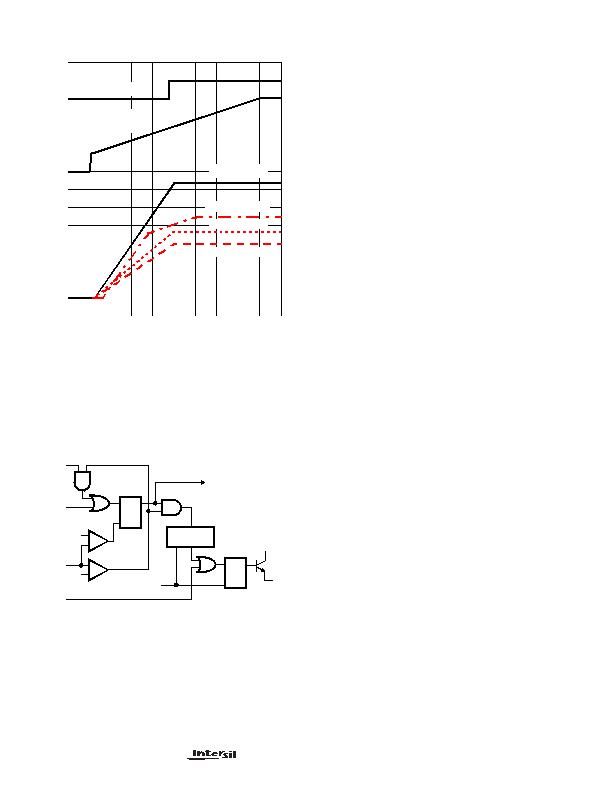
8
Applications Guidelines for a procedure to determine the
soft-start interval.
Fault Protection
All four outputs are monitored and protected against extreme
overload. A sustained overload on any output or an over-
voltage on V
OUT1
output (VSEN1) disables all outputs and
drives the FAULT/RT pin to VCC.
Figure 4 shows a simplified schematic of the fault logic. An
over-voltage detected on VSEN1 immediately sets the fault
latch. A sequence of three over-current fault signals also
sets the fault latch. The over-current latch is set dependent
upon the states of the over-current (OC), linear under-
voltage (LUV) and the soft-start signals. A window
comparator monitors the SS pin and indicates when C
SS
is
fully charged to 4V (UP signal). An under-voltage on either
linear output (VSEN2, VSEN3, or VSEN4) is ignored until
after the soft-start interval (T4 in Figure 3). This allows
V
OUT2
, V
OUT3
, and V
OUT4
to increase without fault at start-
up. Cycling the bias input voltage (+12V
IN
on the VCC pin off
then on) resets the counter and the fault latch.
Over-Voltage Protection
During operation, a short on the upper MOSFET of the PWM
regulator (Q1) causes V
OUT1
to increase. When the output
exceeds the over-voltage threshold of 115% of DACOUT, the
over-voltage comparator trips to set the fault latch and turns
Q2 on. This blows the input fuse and reduces V
OUT1
. The
fault latch raises the FAULT/RT pin to VCC.
A separate over-voltage circuit provides protection during the
initial application of power. For voltages on the VCC pin
below the power-on reset (and above ~4V), the output level
is monitored for voltages above 1.3V. Should VSEN1 exceed
this level, the lower MOSFET, Q2 is driven on.
Over-Current Protection
All outputs are protected against excessive over-currents.
The PWM controller uses the upper MOSFETs
on-resistance, r
DS(ON)
to monitor the current for protection
against shorted output. All linear controllers monitor their
respective VSEN pins for under-voltage events to protect
against excessive currents.
Figure 5 illustrates the over-current protection with an
overload on OUT1. The overload is applied at T0 and the
current increases through the inductor (L
OUT1
). At time T1,
the OVER-CURRENT comparator trips when the voltage
across Q1 (i
D
" r
DS(ON)
) exceeds the level programmed by
ROCSET. This inhibits all outputs, discharges the soft-start
capacitor (C
SS
) with a 10mA current sink, and increments
the counter. C
SS
recharges at T2 and initiates a soft-start
cycle with the error amplifiers clamped by soft-start. With
OUT1 still overloaded, the inductor current increases to trip
the over-current comparator. Again, this inhibits all outputs,
but the soft-start voltage continues increasing to 4V before
discharging. The counter increments to 2. The soft-start
cycle repeats at T3 and trips the over-current comparator.
The SS pin voltage increases to 4V at T4 and the counter
increments to 3. This sets the fault latch to disable the
converter. The fault is reported on the FAULT/RT pin.
The linear controllers operate in the same way as the PWM
in response to over-current faults. The differentiating factor
for the linear controllers is that they monitor the VSEN pins
for under-voltage events. Should excessive currents cause
the voltage at the VSEN pins to fall below the linear under-
voltage threshold, the LUV signal sets the over-current
latch if C
SS
is
fully charged. Blanking the LUV signal during
the C
SS
charge interval allows the linear outputs to build
above the under-voltage threshold during normal operation.
Cycling the bias input power off then on resets the counter
and the fault latch.
FIGURE 3. SOFT-START INTERVAL
0V
0V
0V
TIME
PGOOD
SOFT-START
(1V/DIV)
OUTPUT
(0.5V/DIV)
VOLTAGES
V
OUT1
(DAC = 2.5V)
V
OUT2
( = 3.3V)
V
OUT4
( = 1.8V)
V
OUT3
( = 1.5V)
T1
T2
T3
T0
T4
FAULT
LATCH
S
R
Q
POR
COUNTER
OC1
OV
LUV
+
-
+
-
0.15V
4V
SS
VCC
FAULT
R
FIGURE 4. FAULT LOGIC - SIMPLIFIED SCHEMATIC
UP
OVER-
CURRENT
LATCH
INHIBIT
S
R
Q
HIP6021
发布紧急采购,3分钟左右您将得到回复。
相关PDF资料
HIP6521CB-T
IC REG QD BCK/LINEAR SYNC 16SOIC
HMC920LP5E
IC CTRLR ACTIVE BIAS 32QFN
IDTTSE2002B3CNRG
IC TEMP SENS EEPROM DFN-8
IPM6220ACAZ-T
IC REG 5OUT BUCK/LDO SYNC 24SSOP
IR2170
IC CURRENT SENSE 600V 1MA 8-DIP
IR2171STR
IC CURRENT SENSE 8SOIC
IR2172S
IC CURRENT SENSE 8SOIC
IR2175STR
IC CURRENT SENSE 0.5% 8SOIC
相关代理商/技术参数
HIP6021CBZ
功能描述:电压模式 PWM 控制器 SINGLE PWM & TRPL LINEAR CNTRLR RoHS:否 制造商:Texas Instruments 输出端数量:1 拓扑结构:Buck 输出电压:34 V 输出电流: 开关频率: 工作电源电压:4.5 V to 5.5 V 电源电流:600 uA 最大工作温度:+ 125 C 最小工作温度:- 40 C 封装 / 箱体:WSON-8 封装:Reel
HIP6021CBZ-T
功能描述:电压模式 PWM 控制器 SINGLE PWM & TRPL LINEAR CNTRLR RoHS:否 制造商:Texas Instruments 输出端数量:1 拓扑结构:Buck 输出电压:34 V 输出电流: 开关频率: 工作电源电压:4.5 V to 5.5 V 电源电流:600 uA 最大工作温度:+ 125 C 最小工作温度:- 40 C 封装 / 箱体:WSON-8 封装:Reel
HIP6021EVAL1
功能描述:电源管理IC开发工具 HIP6021 EVAL BRD
RoHS:否 制造商:Maxim Integrated 产品:Evaluation Kits 类型:Battery Management 工具用于评估:MAX17710GB 输入电压: 输出电压:1.8 V
HIP6028
制造商:INTERSIL 制造商全称:Intersil Corporation 功能描述:Advanced PWM and Dual Linear Power Control with Integrated ACPI Support Interface
HIP6028CB
制造商:Rochester Electronics LLC 功能描述:- Bulk
HIP6028CB WAF
制造商:Harris Corporation 功能描述:
HIP6028EVAL1
制造商:INTERSIL 制造商全称:Intersil Corporation 功能描述:Advanced PWM and Dual Linear Power Control with Integrated ACPI Support Interface
HIP6034CB
制造商:未知厂家 制造商全称:未知厂家 功能描述:Analog IC